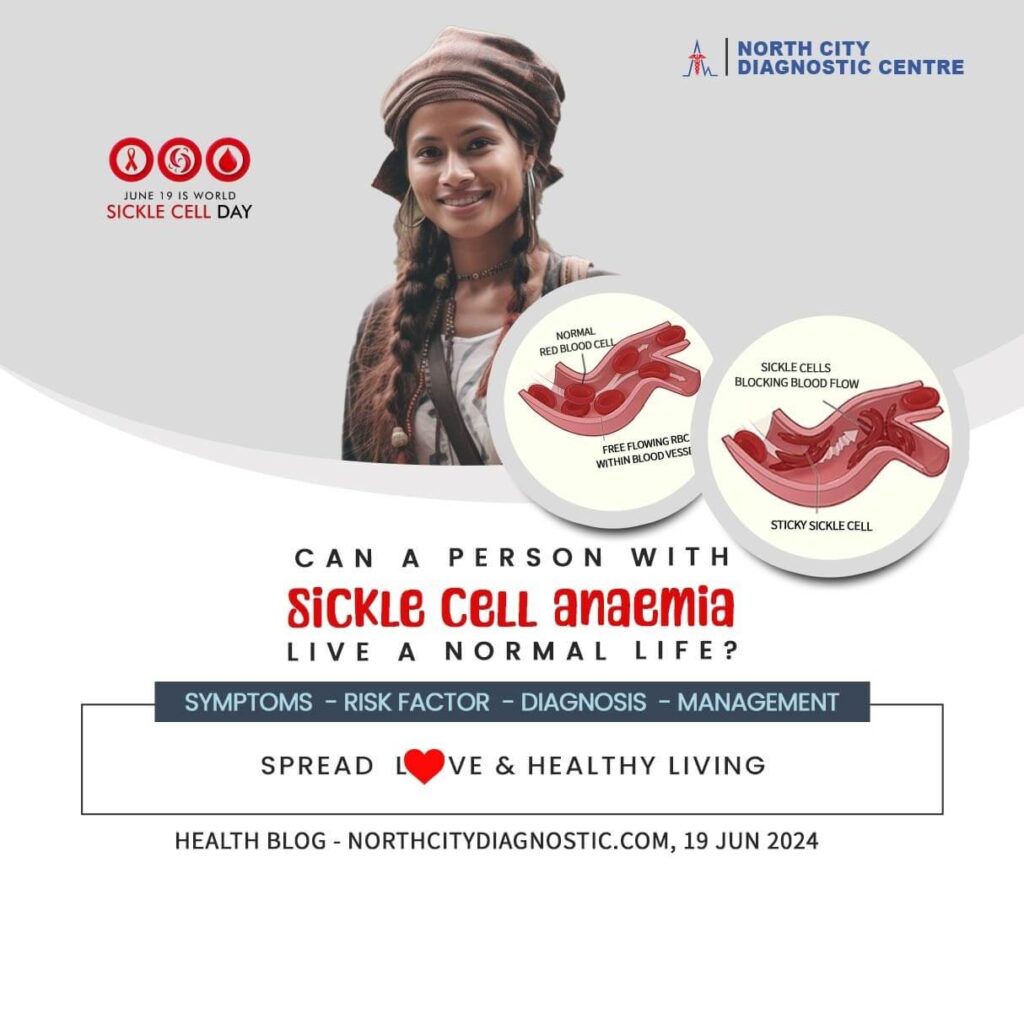
Menu
Living with a chronic condition like sickle cell anaemia (SCA) brings many questions and concerns. One of the most pressing questions is whether it’s possible to lead a normal life with this disease. To truly understand what living with SCA entails, we need to delve into the complexities of the condition, exploring the challenges and strategies for effective management.
“Can I live a normal life with sickle cell anaemia?” asks Rahul, a 20-year-old student recently diagnosed with the condition.
Mr. Soren, a patient living with SCA, responds, “With the right medical care, lifestyle adjustments, and support, many people with sickle cell anaemia live fulfilling lives. It’s all about managing the condition effectively. Look at me.”
Curious Rahul, “Uncle I am terrified. But how do you manage? Can a person with sickle cell anaemia live a normal life? These questions are haunting me!”

Sickle cell anaemia (SCA) is a genetic blood disorder characterized by the production of abnormal haemoglobin, known as hemoglobin S (HbS), within red blood cells. This mutation causes red blood cells, which are typically round and flexible, to assume a rigid, crescent or “sickle” shape. These abnormally shaped cells can obstruct blood flow, leading to painful episodes, anaemia, and potential damage to vital organs.
Pathophysiology
The hallmark of sickle cell anaemia is the sickling of red blood cells. Haemoglobin, the protein in red blood cells that carries oxygen, is defective in this condition. Under low oxygen conditions, haemoglobin S polymerizes, leading to the distortion of red blood cells into a sickle shape. These sickle cells are less flexible and can adhere to blood vessel walls, causing blockages and restricting blood flow. This impeded circulation results in severe pain and damage to tissues and organs.
Genetic Basis
Sickle cell anaemia is inherited in an autosomal recessive pattern. This means a child must inherit two copies of the sickle cell gene—one from each parent—to manifest the disease. Individuals with only one copy of the gene are carriers, known as having sickle cell trait, and typically do not show symptoms.
A person with sickle cell anaemia has a wide range of symptoms, varying in severity and frequency among individuals. These symptoms arise primarily from the blockage of blood flow caused by sickle-shaped red blood cells and chronic haemolysis (destruction of red blood cells).
Here are the most common symptoms:
Acute pain, known as sickle cell crisis, is the most common symptom. It can occur suddenly and last from hours to days.
Pain usually occurs in the bones, joints, abdomen, and chest, and can be severe enough to require hospitalization.
Due to the rapid breakdown of sickle cells (which have a lifespan of about 10-20 days compared to the normal 120 days), individuals often experience chronic anaemia.
Symptoms of anaemia include fatigue, weakness, shortness of breath, and dizziness.
A person with sickle cell anaemia may have painful swelling in the hands and feet, often seen in infants and young children, is a result of blocked blood flow.
Sickle cells can damage the spleen, an organ that helps fight infections. As a result, individuals with SCA are more susceptible to bacterial infections.
Children with SCA often grow more slowly and reach puberty later than their peers due to chronic anaemia.
Sickle cells can block small blood vessels in the eyes, causing damage to the retina and leading to vision problems.
Persistent blockages and reduced blood flow can cause damage to organs such as the liver, kidney, lungs, and heart in a person with sickle cell anaemia.
The rapid breakdown of red blood cells can lead to an accumulation of bilirubin, causing a yellowing of the skin and eyes.
Diagnosis of sickle cell anaemia involves several haematological tests that assess the presence of sickle cells and abnormal haemoglobin. Here are the key parameters and tests used:
Haemoglobin and Haematocrit Levels: These are usually lower in individuals with SCA, indicating anaemia.
Reticulocyte Count: Elevated reticulocyte count signifies increased red blood cell production by the bone marrow in response to chronic anaemia.
A microscopic examination of a blood smear can reveal the characteristic sickle-shaped red blood cells. Additionally, the smear may show other abnormal features such as:
Target Cells: Red blood cells with a bulls eye appearance.
Howell-Jolly Bodies: Nuclear remnants in red blood cells, indicating functional asplenia (non-functioning spleen).
This test separates different types of haemoglobin based on their movement in an electric field. It can quantify the proportions of haemoglobin types present:
Haemoglobin S: Predominant in sickle cell anaemia.
Haemoglobin F: Foetal haemoglobin, is often increased in children with SCA.
Haemoglobin A: Normal adult haemoglobin, absent or present in reduced amounts in individuals with sickle cell anaemia.
HPLC is a highly accurate test to measure the different types of haemoglobin. It provides a detailed analysis and is often used to confirm the diagnosis.
The solubility test detects the presence of haemoglobin S based on its tendency to form crystals when deoxygenated. It is a rapid screening tool but does not distinguish between sickle cell trait and sickle cell anaemia.
Molecular genetic testing can identify mutations in the HBB gene, confirming the diagnosis and differentiating between carriers and those with the disease. This test is especially useful for prenatal diagnosis and family planning.
Early diagnosis and understanding of symptoms can prevent complications and improve quality of life. Recognizing symptoms early helps in:
Managing the disease involves a combination of medical treatments, lifestyle changes, and supportive care. Here are key aspects:
Hydroxyurea is a medication often used on a person with sickle cell anaemia. It can reduce the frequency of painful episodes and acute chest syndrome (ACS) by about half, and it also lowers the need for blood transfusions in adults by around 50%. However, it can have side effects such as reduced white blood cell count (neutropenia), bone marrow suppression, increased liver enzymes, loss of appetite, nausea, vomiting, and potential infertility.
Pain medications, heating pads, and hydration can help manage pain crises.
Eating a balanced diet, staying hydrated, avoiding extreme temperatures, and managing stress are essential.
Routine visits to a haematologist help monitor the disease and adjust treatments as needed.
Yes, a person with sickle cell anaemia can lead a fulfilling life, especially when diagnosed early and managed effectively. With advancements in medical care and a better understanding of the condition, there are numerous treatment options available to help alleviate symptoms and prevent complications.
Timely diagnosis allows for prompt intervention, enabling healthcare providers to implement tailored treatment plans that address the specific needs of each patient.
Through a combination of medical treatments, lifestyle adjustments, and ongoing support, individuals with sickle cell anaemia can pursue their goals, participate in activities they enjoy, and lead fulfilling lives.
The Ministry of Health and Family Welfare, Govt. of India runs the National Sickle Cell Anaemia Elimination Mission.
Their mission is to enhance the care of all patients with Sickle Cell Disease, ensuring a better future for them. The mission aims to reduce the prevalence of the disease through a comprehensive approach that includes screening and raising awareness.
It envisions eliminating sickle cell anaemia disease as a public health problem in India by 2047. To achieve this, they intend to increase community awareness, implement widespread screening for early detection, establish a robust diagnostic network, and strengthen the monitoring system.
Enhancing the primary healthcare system to include SCD strategies, building the capacity of healthcare teams at all levels, and creating cost-effective intensive interventions at higher care facilities are also a few essential steps that the government of India is taking.
“Living with sickle cell anaemia requires adjustments and proactive management,” says Mr. Soren. “But with the right support, Rahul, you too can achieve your goals and lead a fulfilling life.”
Rahul nods, feeling hopeful. “Thank you, Uncle. I understand now that it’s about managing the condition and not letting it define me.”
At North City Diagnostic Center we offer personalized testing schedule that aligns with your medical history and risk factors. Consistent monitoring can be invaluable for early detection and effective management of arthritis. It’s not just about how often you test but making sure that the tests are aligned with your overall health profile for maximum benefit.
#sicklecell #sicklecellawareness #sicklecellwarrior #sicklecellanemia #sicklecelldisease #sicklecellmatters #sicklecellstrong #sicklecelltrait #sicklecellfighter #sicklecellawarenessmonth #sicklecelladvocate #sicklecellcrisis #sicklecelllife #sicklecelleducation #health #sicklecellwarriors #CSD #SCD #chronicpain #sicklecellsurvivor #sicklecellsupport #sicklecellpain #sicklecellsoldier #sicklecelldisorder #worldsicklecellday #NDC #HealthFist #NorthCity #DiagnosticServices #personwithsicklecellanaemia
35-A ,Canal West Road
Near Gouri Bari Bus Stop
Kolkata – 700004.
Local: +91 33 6605 0888